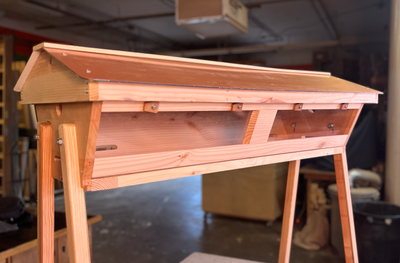Where to Get Bees
Whether you are a seasoned beekeeper or a new-bee, you will want to populate your hives in the spring. For us here in the Pacific Northwest, that means April through early June. The increasing popularity of beekeeping however, requires that bees be purchased, reserved or planned for months in advance. We recommend securing your source for bees by January if you plan to start a hive the following spring.
Below are some of the most common ways to obtain honeybees for your hive.
swarms
Swarming is the natural method honeybee colonies reproduce as a whole. The original colony replaces the old queen, who leaves the hive with roughly half the worker bees and as much honey as they can carry. Swarm clusters land on a structure near their original hive location, while scout bees leave the cluster in search of a new hive location. It is in this stage that swarms can be captured and used to populate an empty hive. Swarms are ready to start building comb in their new home immediately.
Swarms are local to the area they were found in. They are guaranteed to have survived the winter in that climate, and were a strong enough colony to split in early spring. This method of obtaining bees aids in the goal of propagating strong genetics for local honeybee populations. We have had the greatest success with bees caught from swarms in our apiary and find that swarms fare better than bees trucked across the country in packages.
For more information on swarm catching, watch this helpful video.
BAIT & TRAP
When scout bees find a suitable hive location, they return to the cluster and direct the swarm to the new hive location with the waggle dance. Once the swarm reaches their destination, the first worker bees on the premises gather at the entrance and fan their nasonov glands, releasing scout pheromone to direct the rest of the bees into the new hive. This pheromone resembles the scent of lemongrass oil, and beekeepers can use small amounts of the oil in their hives or in swarm traps to lure in a swarm.
Check out these books for more information about how swarms find new hive locations, and about setting swarm traps.
packages
Honeybee packages are screened boxes that contain a single inseminated-queen in a cage, and 3 pounds of worker bees (about 10,000 individuals). Packages come from breeders, and can be used to populate any hive style. They sell quickly so find an apiary near you to reserve one as early as possible for a guaranteed source of bees for the season. A simple internet search for “package bees” will yield many results. Quality of bee packages varies, based on the source.
How to buy a bee package
Watch a video on installing a package
Nucleus boxes
A nucleus colony is essentially a mini-hive with 3-5 built out frames of honey and brood, with 1 queen and enough worker bees to maintain and expand the hive. They are available from breeders and apiaries, and are most commonly offered as deep Langstroth frames in a wooden or cardboard box. These frames can be transferred into full-sized deep Langstroth hive boxes, and often build up faster than packages since they already have eggs, larvae, and honey stores.
Empty nuc boxes make great swarm catching containers; you can allow your swarm to start building comb in the nuc box and transfer the comb into a compatible hive, rather than needing to install a swarm into their permanent hive right away. We will soon offer top bar nucleus boxes, and already offer deep Langstroth nucleus boxes.
SPLITS
A method used to populate new hives by beekeepers of all hive types, is splitting strong existing colonies. Splits are done by moving frames or top bars of brood including unhatched eggs, honey, and nurse bees from a full colony to a new hive. Make sure the old and new hives have either an existing queen or unhatched eggs; the queenless hive can raise a new queen by feeding a larvae from an unhatched egg only royal jelly. Once the egg has hatched and has already been fed bee bread, the bee is destined to be a worker, and cannot be made into a queen. Some beekeepers choose to buy a queen and add her to the queenless colony. We don't use this method because the colony can requeen on their own, and often we don't support the methods used to raise and inseminate most queens.





